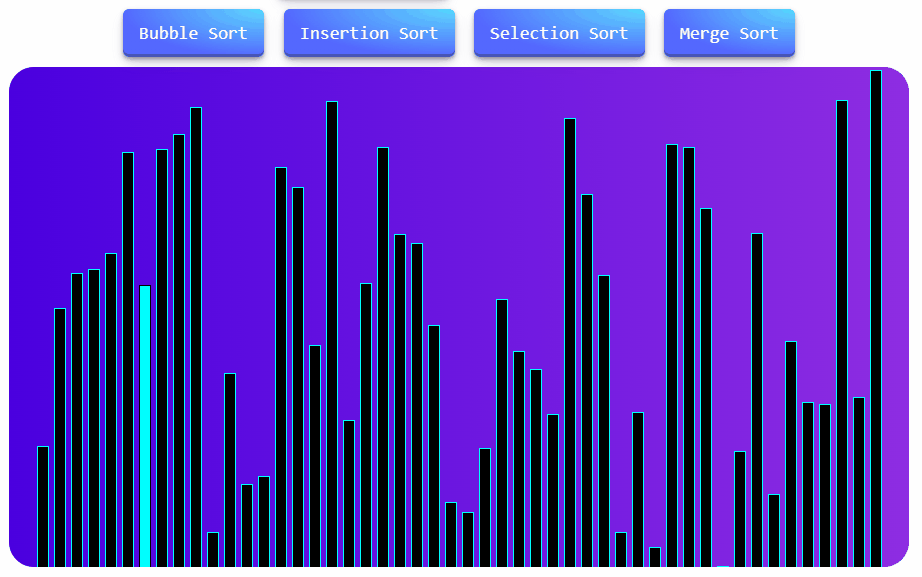- Published on
Sorting Algorithms Visualization
I made a sorting algorithm visualizer that animates the sorting of four popular sorting algorithms. The algorithms include Bubble sort, Insertion sort, Selection sort, and Merge sort. Check out the live website here.
The rest of this blog post will give a brief summary of how it was made. As an example, I'll go over how I implemented insertion sort. I tried to keep the code as simple as possible, therefore I only have 3 JavaScript files along with an HTML and CSS file. The HTML file includes all the buttons that the user can select and the div that contains the rectangles. The rectangles themselves are just div's that are generated via the main.js file. The first line in the main.js file waits for the website to load and then calls the generateArray() function.
document.addEventListener("DOMContentLoaded", generateArray(), false);
The generateArray() function is used to randomly generate 50 rectangles with differing heights.
function generateArray() {
const arrays = document.getElementById("arrays"); // retrieve parent div of rectangles
arrays.innerHTML = ""; // clear any div children within arrays
for (let i = 0; i < 50; i++) {
const rectangle = document.createElement("div"); // create a div element which will represent each rectangle
rectangle.id = "rectangle"; // set id
rectangle.classList.add("default"); // add css class
const height = Math.floor(Math.random() * 500); // generate random size for rectangle
rectangle.style.height = height + "px"; // add previously generated size to height properties of style
arrays.appendChild(rectangle); // add div to arrays parent div
}
}
Now, let's go over how insertion sort is implemented. There are three JavaScript files: main.js, algorithms.js, and helpers.js. In the main.js file, I have the following function for insertion sort which runs when the insertion sort button is clicked.
async function insertionSort() {
await disableButtons(); // disable all buttons so they cannot be clicked
let algorithms = new Algorithms();
await algorithms.InsertionSort();
await enableButtons(); // enable all buttons again after sorting
}
In the function, I create a new Algorithms object and then call the InsertionSort method. Inside the algorithms.js file, I have the Algorithms class where all the algorithms are defined.
class Algorithms {
constructor() {
this.arrays = document.getElementById("arrays"); // parent div of all rectangles
this.rectangles = this.arrays.children; // rectangle divs inside arrays div
this.size = this.rectangles.length; // number of rectangles
this.helpers = new Helpers(this.rectangles); // helper functions
this.speed = document.getElementById("speed").value;
}
// Insertion Sort
async InsertionSort() {
for (let i = 1; i < this.size; i++) {
let j = i - 1;
let key = i;
while (j >= 0 && (await this.helpers.compareElements(j, key))) {
await this.helpers.setCurrent(j);
await this.helpers.swapElements(key, j);
await this.helpers.delay(this.speed);
await this.helpers.removeCurrent(j);
j--;
key--;
}
}
}
}
In the constructor, I've defined variables that are required in all the different algorithm implementations. I also instantiate a Helper object which includes functionality such as highlighing a rectangle, comparing two rectangles, and swapping them.
In insertion sort, I have an element which I label as key and use to compare with the previous element. In the above for loop, my i variable starts at 1 (the second element) which I then set equal to my key variable. The j variable represents the previous element. I compare the key with the previous element and if the key is smaller, I swap the elements. Using the while loop, I then continue to compare the key with the previous element and if the key is smaller again, I again swap the elements. I continue to do this until either the previous element is equal to the first element in the array, or the previous element is smaller than the key. I use the compareElements helper function to compare the key with the previous element j.
// compare the heights of 2 different rectangles
async compareElements(i, j) {
let height1 = Number(this.rectangles[i].style.height.match(/(\d+)/)[0]);
let height2 = Number(this.rectangles[j].style.height.match(/(\d+)/)[0]);
if (height1 > height2) {
return true;
} else {
return false;
}
}
If the previous element is larger, then the swapElements function is called.
// swap the height values of two elements
async swapElements(i, j) {
let height1 = Number(this.rectangles[i].style.height.match(/(\d+)/)[0]);
let height2 = Number(this.rectangles[j].style.height.match(/(\d+)/)[0]);
this.rectangles[i].style.height = height2 + "px";
this.rectangles[j].style.height = height1 + "px";
}
The last part of the visualization is the actual animation component. This component is quite basic and involves called the setCurrent function which removes the default css class and adds a different css class.
async setCurrent(i) {
this.rectangles[i].classList.remove("default");
this.rectangles[i].classList.add("current");
}
The removeCurrent method does the opposite of the setCurrent method. In order to actually see the rectangle change color, I use the delay helper function. The delay function uses the built-in setTimeout function to resolve a promise after a certain number of milliseconds.
// delay for animation
async delay(time) {
await new Promise((resolve) => setTimeout(resolve, time)); // wait for animation
}
The time value is set by the user using the slider. Now, let's take a look at insertion sort in action. The full code is available on my github.

